Dnipro
Dnipro [Дніпро; Dnipro]. Map: V-15. City (2018 pop 1,000,506), located in the northern part of the steppe belt on the Dnipro River (its main section is on the higher right bank) above the former Dnipro Rapids, at the juncture of the Dnipro River route with the Donbas–Kryvyi Rih railroad. Until 1926 it was called Katerynoslav and then until 2016 it was called Dnipropetrovsk. Dnipro is the third-largest city in Ukraine and one of the largest metallurgical and machine-building centers in Ukraine. It is a railroad center, river port, airport, an important cultural center, and the capital of Dnipropetrovsk oblast.
History. Katerynoslav was founded in 1776 by Prince Grigorii Potemkin, the colonizer of southern Ukraine, at the site of the Cossack sloboda of Polovytsia, built by the Cossack Ivan Hloba. The town was named after the Russian empress Catherine II. Development proceeded according to a general plan proposed by architects I. Starov in 1790 and V. Geste in 1817. The town was to be the main center for the whole southern part of the Russian Empire, but after Potemkin’s death in 1791, Katerynoslav declined, and by Paul I’s decree was renamed Novorossiisk in 1797 (a name it retained until 1802). In 1802 the town became a gubernial center (see Katerynoslav gubernia). In 1804 the Poltava theological seminary was moved to Katerynoslav, and a year later the first gymnasium was opened. In 1847 the first town theater was built. Until 1870 Katerynoslav remained a small commercial and administrative center of an agricultural steppe gubernia. In 1861 the town’s population was 19,000. The town developed around Katerynynskyi Prospekt, a central artery extending along the Dnipro River, with a rather unsystematic layout of its one- and two-story buildings. Katerynoslav’s economic importance depended on the Dnipro River’s navigability above the Dnipro Rapids: the town served as a reloading port for the grain, lumber, and wool trades.
The intensive development of Katerynoslav began in the 1870s, when a railroad line was built linking the town with Sevastopol and Kharkiv. In 1883 the Catherine railroad line (called the Dnipro line today) connected the new industrial centers of the Donets Basin and Kryvyi Rih. Since then the city has been at the crossroads of the river route, by which grain and lumber are transported, and the railroad line, which carries iron ore and coal. It quickly became the main center of the metallurgical industry in Ukraine. In 1887 the enormous Alexander Metallurgical Plant of the Briansk Joint Stock Company (today the Dnipro Metallurgical Plant) was opened. In 1889 a pipe-making plant (today the Lower-Dnipro Pipe Plant) was built. Following this, other metallurgical and metalworking companies were set up. By 1913 there were 358 enterprises in Katerynoslav. The metallurgical and metalworking industries accounted for two-thirds of the town’s production. As industry developed, the population increased rapidly. The town had 47,000 inhabitants in 1887, 121,000 in 1897, 218,500 in 1912. Most of the labor force was brought in from Russia. Almost 40 percent of the population was Jewish. By 1914 Katerynoslav was the fourth-largest city in Ukraine after Odesa, Kyiv, and Kharkiv. In the 19th century the classical style of architecture (eg, Grigorii Potemkin’s palace, built by I. Starov in 1787–9, and the cathedral, built by A. Zakharov in 1830–5) was replaced by an eclectic style (the town hall and various business buildings). As the central town, which stretches in one direction for several kilometers, was built up, the Catherine Prospect became a continuous corridor of stone. Katerynoslav expanded at the end of the 19th and the beginning of the 20th century, mainly at the cost of the suburbs (Kaidaky, Mandrykovka, Diievka, etc), where commercial buildings alternated with one-story homes. As the city grew, it expanded onto the left bank of the Dnipro River at the turn of the century and was connected by three bridges (the first one having been built in 1884).
Ukrainian national-cultural life developed slowly in the young Russified town. In the 1860s and 1870s Katerynoslav was visited briefly by Oleksander Konysky, Mykhailo Komarov, and H. Zaliubovsky, who collected ethnographic materials in the area. In the 1880s cultural activities became somewhat intensified through the efforts of a small circle of Ukrainians associated with the weekly Step'. The weekly began to be published in 1885 in Russian, but it sometimes contained Ukrainian material. The circle was headed by the poet and ethnographer Ivan Manzhura, who in 1884–93 alternated his residence between Katerynoslav and the village of Manuilivka. In almost every year during the 1890s the city hosted touring Ukrainian theatrical troupes, with such famous actors as Marko Kropyvnytsky, Panas Saksahansky, Mykola Sadovsky, and Mariia Zankovetska. In 1911 the Winter Theater was built to accommodate such troupes. In the 1900s national-cultural work increased significantly: at the end of 1905 one of the most active Prosvita societies in Russian-dominated Ukraine was established in Katerynoslav. This society soon organized a network of branches in the villages, and it withstood the pressures of the local civic administration in the years of reaction (1908–13). After the outbreak of the First World War, the society continued to function under the cover of the Ukrainian branch of the Russian Scholarly Society. New repressions following the trial of the Katerynoslav group of Social Democrats (see Russian Social Democratic Workers' party) put an end to the society’s activities in 1915. In 1909–13 the biweekly Dniprovi khvyli came out under Dmytro Doroshenko’s editorship. In this period the most active members of the Ukrainian intelligentsia were Doroshenko, Antin Syniavsky, Vasyl Bidnov, Dmytro Yavornytsky, Adriian Kashchenko, and M. Bohuslavsky. Nataliia Doroshenko attempted to organize a Ukrainian workers’ theater. In 1915, despite strict police surveillance, a Ukrainian group of Social Democrats became very active among the Ukrainian workers of Katerynoslav, who were mostly under the influence of Russian Social Democratic propaganda. The group’s members were arrested and exiled to Siberia.
With the outbreak of the Revolution of 1917 the Ukrainian community in Katerynoslav became more active. Among its leaders were Ivan Truba, Vasyl Bidnov, L. Bidnova, Yevhen Vyrovy, Isaak Mazepa, Panas Fedenko, Serhii Yefremov, and O. Yefremov. The work of the Prosvita society was renewed, education began to be Ukrainianized, and one of the first Ukrainian gymnasiums was established in 1917. Through Vyrovy’s efforts, the Ukrainske Vydavnytstvo publishers grew into an important firm. In the autumn of 1917 the Haidamaka Garrison (Kurin) (see Haidamaka Units of the Army of the UNR) was organized at the initiative of Col Mykhailo Omelianovych-Pavlenko, I. Truba, S. Yefremov, and O. Yefremov. The brothers H. and M. Horobets formed units of the Free Cossacks from local workers and peasants to fight the Bolsheviks. Because of strong Bolshevik propaganda among the workers, many of whom were not Ukrainian, Katerynoslav had become one of the strongholds of the Bolsheviks in Ukraine. Emmanuil Kviring was the local party leader. During the Ukrainian struggle for independence (1917–20) Katerynoslav changed hands many times. The proximity of Nestor Makhno’s anarchist forces complicated matters even more. In 1919 Makhno captured the city and plundered it several times.
The civil war, the frequent changes of government, the destruction of commercial firms, War Communism, Bolshevik requisitions, and the famine of 1921–3 contributed to the decline of the city. In 1923 it had barely 123,000 inhabitants. Only in late 1925 was some of the industry (92 large enterprises) rebuilt. The Petrovsky Plant (ie, the Dnipro Metallurgical Plant), the Lenin Pipe Plant (ie, the Dnipro Pipe Plant), and the Comintern Plant were in operation. In 1926 Katerynoslav was amalgamated with the town of Amur-Nyzhnodniprovskyi on the Dnipro River’s left bank and renamed Dnipropetrovsk. Compared to the prewar figures, the proportion of Ukrainians in Dnipropetrovsk increased, and the proportion of Russians and Jews declined (according to the 1926 census, of the 232,900 inhabitants 35.9 percent were Ukrainians, 31.5 percent were Russians, and 26.7 percent were Jews). In the 1930s new plants were built: the Dnipropetrovsk Metallurgical Equipment Plant (1932–4), the coke-chemical division of the Petrovsky Plant (the Dnipro Coke-Chemical Plant), and others. In 1932 Dnipropetrovsk accounted for 20 percent of the pig iron and almost 25 percent of the steel and rolled steel produced in Ukraine. By 1939 the population had risen to 501,000.
In the period of Ukrainization the schools, institutions of higher education, and scholarly life in general were Ukrainized. The number of Ukrainian newspapers increased. More and more Ukrainian books were published. The Dnipropetrovsk Scientific Society of the All-Ukrainian Academy of Sciences co-ordinated scholarly activities from 1925 on. Dmytro Yavornytsky, Volodymyr Parkhomenko, Yu. Korshun, Petro Yefremov, M. Zlotnykov, M. Brechkevych, and I. Stepaniv were its most prominent members. But by 1929 the terror that was sparked by the show trial of the Union for the Liberation of Ukraine claimed its first victims in the scholarly community, and at the beginning of the 1930s the Scientific Society ceased its activity. Literary creativity could not develop to its full potential, although it continued to exist within such Soviet organizations as Pluh and the All-Ukrainian Association of Proletarian Writers. The journal Zoria (Dnipropetrovsk) came out briefly. In the 1930s prominent writers were arrested and deported.
During the Second World War Dnipropetrovsk, which was one of the main centers of anti-German resistance, sustained extensive destruction, particularly in 1941 with the retreat of the Red Army and in 1943 with the German retreat. Damages to the city during the war were estimated at three billion rubles. By 1943 its population was only 280,000. During the German occupation the Ukrainian National Committee, headed by Borys Andriievsky, was active in the cultural and educational field.
In 1943 the reconstruction of the city’s economy began. At the beginning of the 1950s the automobile industry was established, and new plants producing communications equipment, mining machinery, and other materials were built. In 1956 the city’s population exceeded 1939 figures, reaching 575,000; by 1959 it was 690,000. According to the 1959 census, Ukrainians constituted 59 percent of the population, Russians 29 percent, and Jews 8 percent. In 1970 the population was 904,000. In 1979 it was 1,066,000 and in 1989 it reached 1,178,000.
In 2016 as part of Ukraine’s de-Communization campaign, the city was renamed Dnipro.
Economy. Dnipro is one of the largest industrial centers of Ukraine. Its development is based on enormous energy resources: the Dnipro Hydroelectric Station and Kamianske Hydroelectric Station, the Kryvyi Rih Regional Electric Station, Donbas coal, Shebelynka natural gas, and iron ore from the Kryvyi Rih region (see Kryvyi Rih Iron-ore Basin). \In 1976 there were over 200 industrial enterprises in Dnipropetrovsk: 111 of them were devoted to ferrous and non-ferrous metallurgy, 18 to machine building, 41 to various metal products, 5 to chemicals, and 18 to light industry. Today the main industries of the city are the metallurgical industry, machine building, chemical industry, and building-materials industry. The largest and oldest plant is the Dnipro Metallurgical Plant. Some divisions of this plant eventually became separate firms. The more important firms of the metallurgical industry are the Dnipro Pipe Plant, the Kominmet Plant (rolled steel), and the Lower-Dnipro Pipe Plant. The key plants of the machine-building industry are a metallurgical equipment plant, the Metal-Constructions Plant, the Heavy-Paper-Manufacturing-Machine-Building Complex, machine-tool plants, the Svitlofor Plant (railway signals and equipment), the Steam-Engine and Coach Repair Plant, the Dnipro Agricultural Machinery Plant, and an electric-coach plant. The chemical industry consists of the Dnipro Coke-Chemical Plant, the Lomonosov Paint and Lacquer Plant, the Plastmas Plastics Plant, and a tire plant. Building materials are produced by a silicates plant (fire-resistant materials and cement). There are a number of woodworking, light-industry, and food-industry enterprises. Dnipro exports industrial products to over 50 foreign countries.
Dnipro is an important transportation center. Here the Donbas–Kryvyi Rih and the Kharkiv–Kherson railroad lines intersect with the Dnipro River route. The city has 12 freight stations and three passenger stations. Its river port is one of the largest on the Dnipro River and consists of four sections. Dnipro has airline communications with the main cities of Ukraine and central and western Europe.
Education and culture. Dnipro has several major scientific research institutes and engineering-design institutes, most of which were connected with heavy industry. Among them are the Dnipro Scientific Center of the National Academy of Sciences of Ukraine, the Scientific Research Institute of Ferrous Metallurgy and the Automation Institute of the National Academy of Sciences of Ukraine; the Institute of Physical Chemistry of the National Academy of Sciences of Ukraine; the Scientific Research Institute of Pipes; the Institute of the Coke Industry; the Institute of Epidemiology, Microbiology, and Hygiene; and the Scientific Research Institute of Corn. There are twenty institutions of higher education, among them nine universities (Dnipro National University, Dnipro University of Technology, Dnipro National University of Railway-Transport, Dnipro State Agrarian University, and others); five academies, including National Metallurgical Academy of Ukraine, Dnipro State Academy of Civil-Engineering and Architecture, Dnipropetrovsk Medical Academy, and others; and six institutes. The city has 163 schools, including lyceums and tekhnikums, and 17 specialized schools. The city has a philharmonic orchestra, a circus, and two theaters—the Dnipropetrovsk Academic Ukrainian Music and Drama Theater (1927), the Dnipro Academic Theater of Drama and Comedy (1847), the Dnipropetrovsk Academic Opera and Ballet Theater (1974), and a puppet theater. Its most important museums are the Dnipropetrovsk National Historical Museum (1905), the Dnipropetrovsk Art Museum (1914), and the zoological museum at the Dnipro National University. The city boasts over 400 libraries holding over 25 million items. Among them are the Dnipropetrovsk Oblast universal library, the university library, the mining academy library, and the technological library of the Dnipro Metallurgical Plant. The oblast archives hold documents dating back to the 18th century. There are local branches of the Writers' Union of Ukraine and the Union of Artists of Ukraine. Since 1958 the city has had its own television station.
Character of the city and environs. Dnipro is situated on the banks of the Dnipro River and is bisected by the river. On the right bank stands the city center, the oldest part of the city. It occupies a large area, stretching for 5 km from the southwest to the southeast and bounded on one side by the Dnipro River and on the other by Pushkin Prospect. The main axis of the city center and the city as a whole is Dmytro Yavornytsky Prospect (formerly Catherine Prospect and marx Prospect), which begins near the Pryvokzalna (Station) Square in the western, lower part and runs uphill for 4 km. The prospect is 50–80 m wide and is lined with ancient acacia trees. The main administrative and public buildings stand on the prospect; these include the Dnipro National University, the Shevchenko Theater (see Dnipropetrovsk Academic Ukrainian Music and Drama Theater), the Dnipro Academic Theater of Drama and Comedy, the puppet theater, the philharmonic hall, and cinemas. The oldest section of the city lies on the eastern edge of the city center and was to be the city center according to the development plan of 1790. Here stands the Cathedral of the Transfiguration, built in 1830–5 by the architect A. Zakharov. On the slopes of the riverbanks lies Shevchenko City Park and the former Grigorii Potemkin palace (now the Student Palace). The main industrial section of the city lies west of Pryvokzalna Square along the river and the railroad. The main plants are found here as well as loading terminals and shipping docks. The southern part of the city is the newest industrial and residential area. In 1969–71 a large residential development of 9- to 20-story apartment buildings went up. The Amur-Nyzhnodniprovskyi raion, which is of great economic importance, lies on the left bank of the Dnipro River. Ferrous-metallurgical, machine-building, and equipment-making plants, the Nyzhniodniprovskyi Station, and a shipping port are found there. North of this raion the large Novomoskovskyi residential development was built in 1961–6.
Dnipro is one of the greenest cities in Ukraine. There are 12 parks and other green areas, covering an area of 1,330 ha. Among them is Hloba Park, with a children’s railroad and a pond, Shevchenko Park, and Zelena Dibrova Park.
The main means of urban transportation are the streetcar (1898), trolleybus (1947), and bus.
BIBLIOGRAPHY
Shvidkovskii, O. Dnepropetrovsk (Moscow 1960)
Vyznachni mistsia Dnipropetrovshchyny (Dnipropetrovsk 1967)
Tvii ridnyi krai (Dnipropetrovsk 1968)
Shatrov, M. Gorod na trëkh kholmakh. Kniga o starom Ekaterinoslave, 2nd edn (Dnipropetrovsk 1969)
Boiko, V. ‘Dnipropetrovs'ku—200 rokiv,’ UIZh, 1976, no. 5
Chaban, M. Vichnyi khrest na hrudiakh zemli (Dnipropetrovsk 1993)
________. U staromu Katerynoslavi (1905–1920 rr.) (Dnipropetrovsk 2001)
Fomenko, A. et al (eds). Dnipropetros'k: Mynule i suchasne (Dnipropetrovsk 2001)
Mykola Hlobenko, Volodymyr Kubijovyč
[This article was updated in 2018.]

.jpg)
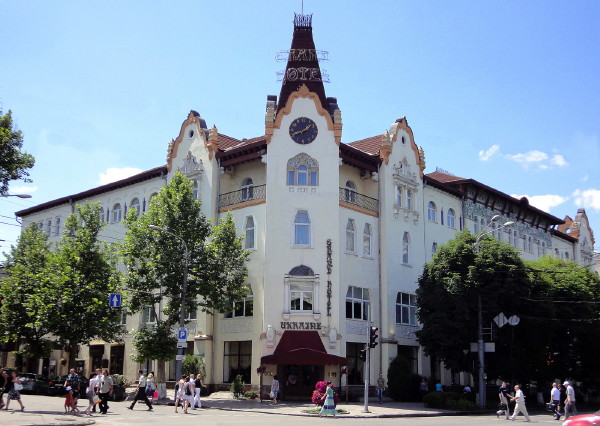
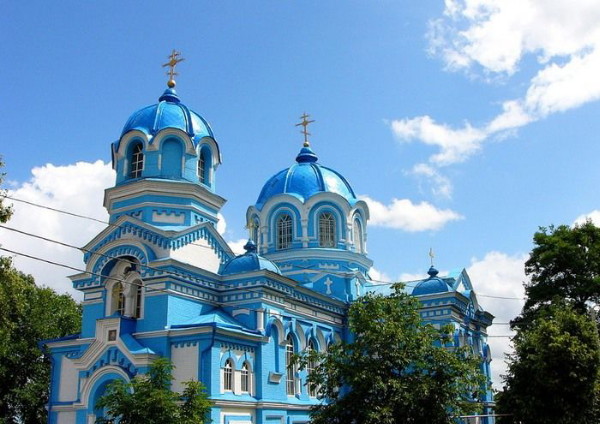
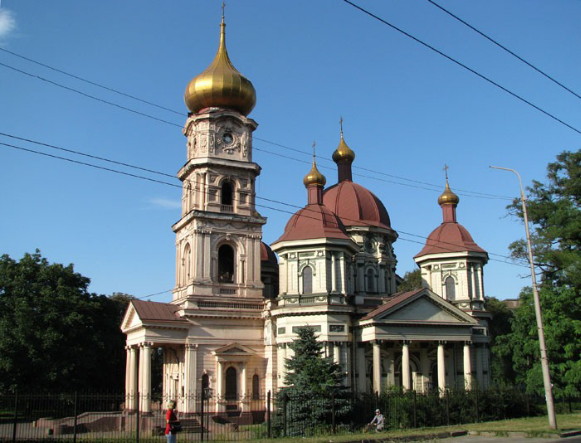
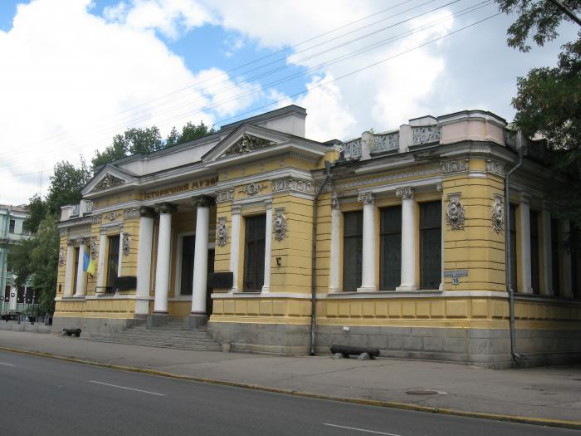
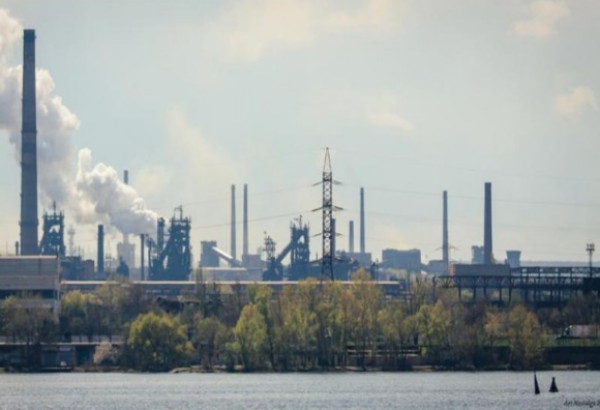
.jpg)